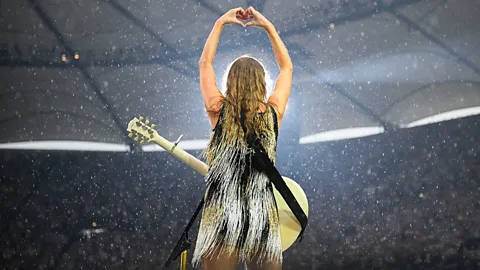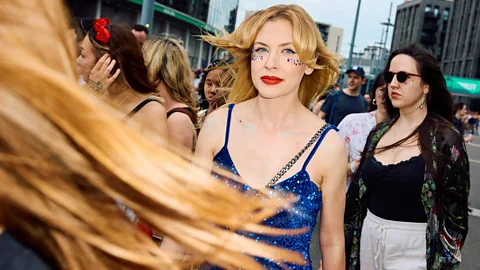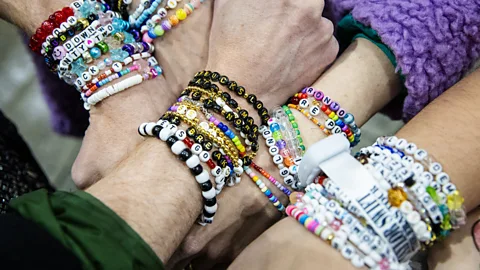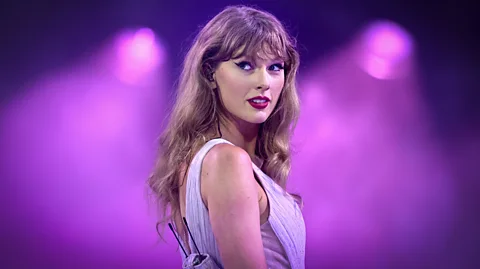 Getty Images
Getty ImagesTaylor Swift’s Eras Tour, a “cultural juggernaut” remarkable for both its scale and intimacy, comes to an end this week. Along the way, it has become the most extraordinary live event of our time – and for many, it’s meant even more.
This weekend, after 20 months, 149 shows, a blockbuster concert film and millions of friendship bracelet swaps, Taylor Swift’s Eras Tour finally comes to an end in Vancouver, Canada.
Less a live show than a cultural juggernaut steamrolling into 53 cities across five continents, the Eras Tour has dominated headlines, boosted national economies (and craft sales), caused mini-earthquakes and broken countless records – including becoming the highest-grossing tour of all time (experts believe it will top $2bn (£1.6bn) – and that doesn’t include merchandise). Since she kicked off the live shows in March 2023, Swift has released three albums (re-recordings of Speak Now and 1989, and The Tortured Poets Department), snagged her fourth album of the year Grammy – the first artist to do so – and embarked on a high-profile relationship with NFL star Travis Kelce (who made a cameo on the Eras Tour). She has called the end of the tour “the closing of the most extraordinary chapter of my life so far“.
The sheer scale and cultural dominance of the Eras Tour, from the record attendances to the 3.5-hour setlist, is undeniable. In the almost two years it’s been going, it has become its own news cycle – even if you didn’t attend, you’ve probably seen the videos of Prince William or Tom Cruise dancing at the show, or heard about world leaders begging Swift to give their country an economy-boosting visit. We live in an era of blockbuster live shows, but there’s never been anything quite as colossal as this. It’s hard to see how anyone, including Swift herself, will top it anytime soon.
And yet, if Swift’s shows were remarkable for their size, they were also striking for their against-the-odds sense of intimacy. Attending the Eras Tour felt less like bowing down to a global megastar, and more like a mass, sequinned meet-up. Earlier this year Variety magazine dubbed her “the world’s greatest community organiser”.
 Getty Images
Getty ImagesBeing relatable has long been Swift’s calling card. Even as her fame and wealth has soared (she joined the Forbes World’s Billionaires List earlier this year), she’s continued to keep fans believing that she’s not really all that different from them. This starts with her songs: universal experiences – heartache, betrayal, loss, revenge, regret – written about with remarkable specificity. But she’s also carefully cultivated that feeling of inclusivity at her live shows.
From the stage, which extends two-thirds of the way into the stadium so that Swift spends most of the show in the middle of the crowd, to her use of “we” and “us” (“We’re about to go on a little adventure together…”) to the LED wristbands that turn the crowd into part of the show (Coldplay pioneered this at their gigs), the whole thing is designed to feel like a collective experience. Swift first emerges from a puff of pastel parachutes to ecstatic, ear-piercing screams. For a few minutes, up on a raised platform, she seems celestial. Then she smiles, utters “Oh hi!” as if she’s greeting old friends, and the untouchable suddenly becomes attainable.
The show runs like clockwork, but Swift changes just enough to make each night feel unique for the audience. In her short acoustic set she’s never repeated the same combination of surprise songs and deep-cut mash-ups. She has greeted the crowds in languages including Welsh, Portuguese, Spanish, and French. In every city, one of her backing dancers, Kameron Saunders, utters a locally-tailored put down during We Are Never Getting Back Together (in Ireland: “the neck of ye”, London: “up yours…”, Edinburgh: “bolt ya rocket”). In May, Swift added a new segment to the setlist, featuring songs from this year’s The Tortured Poet’s Department, including the single I Can Do It with a Broken Heart, a track written about performing on the Eras Tour with a broken heart.
A ‘communal belonging’
The tour has been a rolling stone, gathering not moss, but new traditions and meaning along the way. Fans have created their own rituals that have become baked into the show – an ecstatic, extended applause after the song Champagne Problems (which Swift dutifully pretends to be surprised by every time), chanting Kendrick Lamar’s lines from his remix to Bad Blood, and, of course, the friendship bracelets – a tradition sparked by a lyric in her song You’re On Your Own Kid. In every stadium thousands of forearms are weighed down by stacks of hand-crafted bracelets that are traded with strangers, security guards and even, at one London show, Sir Paul McCartney. For fans, taking part in these moments are as much a part of the experience as the music.
Another customis for fans to scream “take us to church” as Swift hits the high notes of Reputation-era track Don’t Blame Me. Philosopher Simon Critchley, whose recent book On Mysticism explores the transcendent power of music and art, argues that they might already be there. “I think her fans are going to church, or the closest they can get to church,” he tells the BBC. Critchley, who sees music as “maybe the last bastion of something like religious transcendence” thinks Swift is scratching a metaphysical itch for fans. “They don’t think she’s God, but to them she’s someone very special, and she mediates a form of communal belonging that is lacking in other areas of their lives.”
 Getty Images
Getty ImagesPeople have clamoured to experience the Eras Tour – not just hardcore Swifties, but those not wanting to miss out on an era-defining cultural event. Tickets were famously hard to snag, with some fans paying thousands on resale sites. Many fans travelled across the world to attend shows. Those that couldn’t make it converged outside stadiums – in Munich, 40,000 ticketless fans gathered on a nearby hill, not just to be nearer to their idol, but to each other. Every night of the Eras Tour, hundreds of thousands of people have watched grainy fan-filmed livestreams of the shows online. When Swift’s Vienna shows were cancelled due to a terrorist threat, fans gathered in the streets to sing her songs and swap bracelets. “This is devotional practice and the fans are making pilgrimages,” says Critchley. “It’s almost as if the difficulty is part of the experience. If you think about medieval pilgrimages, they were really hard.”
Post-pandemic, live shows have attracted huge demand as people have flocked back to in-person experiences. “That sense of disconnection from each other in Covid and the distrust that went along with that, and the fact that many of us became kind of monks and nuns in ourselves, and were thinking about what we were missing… there’s an intense, metaphysical need to feel together with other people,” says Critchley.
Swift herself recognises this. In the forward to her newly released Eras Tour book, she writes: “We do it because people need an escape from how brutal life can be, and it is the honour of a lifetime to be that for them, if only for a night. And although we are on our own in this big scary life, somehow it doesn’t feel that way when we’re singing the same words as 80,000 other people wearing glittery face paint.”
She’s not the only artist leaning into the communal aspect of the live experience. Beyoncé, explaining her decision to stop making music videos and focus on live shows, told GQ magazine: “The fans from all over the world became the visual. We all got the visual on tour.” Charli XCX’s Brat tour is more like a warehouse rave. Chappell Roan gives her shows themes, with fans encouraged to dress accordingly. “I’m big on crowd participation,” Roan told Nylon. Dressing for the occasion is now a huge part of live shows – many Swifties came as their favourite “Era”. With ticket prices soaring, fans are determined to make the most of these experiences.
Boom and bust
The Eras Tour is part of a boom in live music, with 2023 a record year worldwide – but the industry is top heavy, with the biggest artists benefitting the most. Globally, the largest 100 tours of last year grossed more than $9bn (£7bn). In the UK, the value of the music industry to the national economy hit a record high of £7.6bn ($9.7bn), thanks to tours from big-name acts. At the same time, grassroots music venues are closing at an alarming rate. Musician Kate Nash recently called live shows a “passion project for a lot of artists” while “a select few in the industry become millionaires or even billionaires from touring.”
 Getty Images
Getty ImagesWhereas once people forged their identities in distinct musical tribes, there now seems to be a yearning for something akin to a monoculture. “We live in an asynchronous world where no one’s experiencing the same thing at the same moment, and everything is fragmented,” says Critchley. “So what do we have left to bring us together? Live sports and live concerts.”
In the social media age, fans expect to feel a connection to their pop stars, and that now goes for the live experience too. It’s not enough to see a spectacle – people want to feel a part of something.
It’s when this desire to feel a part of an artist’s world tips over into expectation that things get complicated. At a gig in the summer, Chappell Roan broke down on stage, telling the crowd she was struggling with her rapid rise to fame. The moment went viral, with fans applauding her vulnerability. But when Roan cancelled some shows earlier in the year citing “overwhelming pressure”, she faced backlash for letting people down.
Charli XCX recently revealed to Variety that she has nerve damage in her neck from performances, which leaves her in “a lot of pain” on stage. “For me to give a performance that I feel is good enough, I have to really physically throw myself around,” she explained.
Artists are expected to surrender ever more of themselves, physically and emotionally. It’s something Swift has had to learn to navigate, but if the demands of the Eras Tour have taken their toll, she isn’t letting on. At her penultimate shows in Toronto, Swift got emotional on-stage. “I’m just having a bit of a moment,” she told the crowd. “We have put so much of our lives into this. And you’ve put so much of your lives into being with us.” After nearly two years in the literal spotlight, she’s certainly earned a long break – though, knowing Swift, it won’t be long before she ushers in a brand-new era.
The Eras Tour concludes on 8 December in Vancouver, Canada.

